Wooden kitchen gadgets bring quiet power to daily cooking. They protect nonstick and enamel surfaces, feel comfortable in your hand, and add natural warmth to your workspace. Unlike metal, wood won’t clang or overheat; unlike plastic, it won’t warp near heat or hold stubborn odors when you care for it properly. The result is control, comfort, and longevity—meal after meal.
In this easy, in-depth guide, you’ll learn exactly which wooden gadgets to choose and why. I’ll cover spoons, spatulas, ladles, cutting boards, rolling pins, bowls, mortars, pasta tools, muddlers, tongs, and more. You’ll see how different woods—maple, beech, cherry, walnut, acacia, teak, olive, and bamboo—affect strength, feel, and moisture resistance. I’ll also show you how to pick sizes and shapes that match your cookware, how to recognize quality sanding and safe finishes, and how to clean, dry, and oil your tools so they last for years. Along the way, you’ll get practical tips to fix common issues like fuzzing grain, stains, and warping.
By the end, you’ll know how to build a tight, sustainable kit of wooden tools that works hard, looks great, and ages beautifully.
Why choose wooden kitchen gadgets?
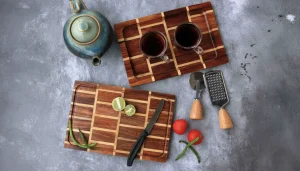
Wood has earned its place beside stainless steel and silicone for good reasons. It’s gentle on cookware, quiet to use, comfortable to grip, and—with the right species and finish—tough enough for daily cooking. It won’t scratch nonstick or enamel, it keeps its cool in hot pans, and it brings a warm, natural look to your space. With simple care, wooden tools can last for years and even look better as they age.
At a glance: benefits
- Cookware-safe: No scratches on nonstick, stainless, or cast iron.
- Heat friendly: Handles heat well and doesn’t get searing hot like metal.
- Ergonomic & quiet: Softer, quieter contact with bowls and pans.
- Sustainable options: Many hardwoods and bamboo are renewable when responsibly sourced.
- Beautiful & repairable: Sand, re-oil, and keep using.
And the trade-offs
- Needs maintenance: Hand-wash, dry promptly, and oil periodically.
- Can stain or absorb odors if neglected.
- Avoid soaking/dishwasher: Prolonged moisture can warp or crack wood.
Wood basics: species, grain, and finish
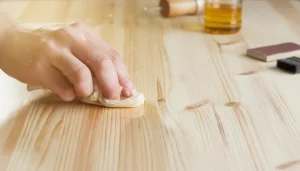
Best woods for kitchen tools
- Maple (hard/soft), Beech, Cherry: Tight grain, durable, and widely used for spoons, boards, and rolling pins.
- Walnut: Dense, dark, and elegant; great for boards and servers.
- Acacia, Teak, Olive: Naturally oily species that resist moisture well—popular for boards, bowls, and serving utensils.
- Bamboo: Technically a grass; lightweight and hard. Often laminated with food-safe adhesives.
Grain orientation for cutting boards
- End-grain: Fibers run vertically; “self-healing” surface that’s gentler on knives. Premium and heavy.
- Edge-grain: Strips on their side; durable, mid-priced, and stable.
- Face-grain: Broad planks; striking look for serving, but softer on the surface.
Food-safe finishes
- Mineral oil & beeswax: Classic, neutral scent, easy to reapply.
- Fractionated coconut oil: Stable and less likely to go rancid than standard cooking oils.
- Pure tung oil (food-safe when fully cured): Harder film finish; allow full cure per maker guidance.
- Avoid standard vegetable oils—they can oxidize and smell.
The complete tour of wooden kitchen gadgets
Below you’ll find the most useful wooden tools, what each does best, what to look for, and care tips.
Wooden Spoons: The Kitchen Workhorse

Wooden spoons are a kitchen staple. They are perfect for stirring sauces, sautéing vegetables, scraping fond, or tasting your creations.
Types of Wooden Spoons:
-
Round-bowl: Ideal for soups and sauces.
-
Oval: Great for mixing and folding.
-
Slotted: Lets liquids drain while stirring.
-
Corner/angled: Reaches pan edges effectively.
-
Risotto spoon (center hole): Perfect for stirring rice dishes evenly.
Choosing the Right Spoon:
-
Look for tight-grained hardwood — it lasts longer and resists cracking.
-
Ensure a smooth bowl edge to prevent food from sticking.
-
Comfortable handle is essential for long stirring sessions.
Care Tips:
-
Wash and dry immediately.
-
Oil occasionally to prevent drying.
-
Sand lightly if fibers rise.
Wooden spoons are versatile and long-lasting. They’re gentle on non-stick and metal pans, making them perfect for daily cooking.
Wooden Spatulas, Turners, and Scrapers
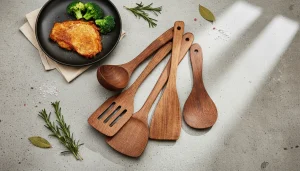
These wooden kitchen gadgets are essential for flipping, folding, and scraping food.
Best Uses:
-
Folding batters.
-
Stirring stews.
-
Flipping delicate foods in non-stick or enamel pans.
Types:
-
Flat scraper: Great for lifting and scraping bowls.
-
Beveled turner: Easy to slide under food.
-
Fish spatula-style: Wider head for delicate fillets.
-
Jar spatula: Narrow and perfect for sticky spreads.
Choosing Tips:
-
Thin yet strong edges for clean lifting.
-
Rounded corners to protect pans.
-
Keep one for baking and one for savory cooking to avoid flavor transfer.
Wooden spatulas and scrapers provide control, durability, and safety for your cookware.
Wooden Ladles and Serving Utensils
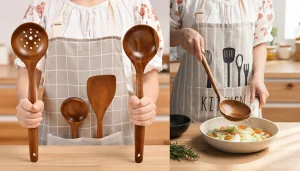
Wooden ladles and serving utensils are excellent for soups, stews, grains, and sauces.
Choosing Tips:
-
Deep bowl to hold liquids effectively.
-
Drip-stop notch helps prevent spills.
-
Long handle works well for stockpots.
Extras:
-
A matching set with slotted and solid spoons makes family meals easy.
-
They are durable, gentle on cookware, and add a rustic charm to your table.
Wooden Cutting Boards: Prep and Carving
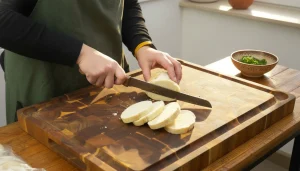
Cutting boards are essential wooden kitchen gadgets for prep work and carving.
Best Uses:
-
Daily chopping and slicing.
-
Bread slicing.
-
Roast carving.
-
Serving platters.
Choosing Tips:
-
Size that fits your sink for easy cleaning.
-
End-grain boards are ideal for heavy knife work.
-
Juice groove is useful for carving roasts.
-
Stability is key: rubber feet or a damp towel prevents slipping.
Care Tips:
-
Wash and stand to dry.
-
Oil or wax regularly to maintain wood.
-
Re-surface with fine sandpaper if rough.
A good wooden cutting board is durable, gentle on knives, and stylish.
Bread Boards & Cheese Boards

Bread and cheese boards are both functional and decorative.
Choosing Tips:
-
Face-grain or edge-grain for flat, beautiful surfaces.
-
Ideal for serving bread, cheese, or charcuterie.
Care Tips:
-
Oil lightly to protect wood.
-
Avoid cutting raw meat to prevent contamination.
These boards are perfect for presentation while maintaining the practicality of everyday use.
Rolling Pins
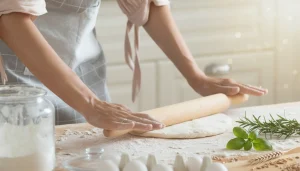
Rolling pins are essential for pies, cookies, laminated doughs, and flatbreads.
Styles:
-
French (tapered dowel): Excellent control, easy to pivot.
-
Straight dowel: Provides even thickness.
-
Handled pins (with bearings): Smooth rolling with less effort.
-
Embossed pins: Creates decorative patterns for cookies or fondant.
Choosing Tips:
-
Smooth finish and straight grain.
-
Balanced weight for better control.
Care Tips:
-
Wipe clean after use, never soak.
-
Re-oil sparingly to prevent tackiness.
Rolling pins make baking consistent, professional-looking, and enjoyable.
How to choose quality wooden gadgets
- Look for tight grain and smooth sanding. No splinters or rough edges.
- Feel the balance. Tools should feel secure, not tip-heavy.
- Check joinery on boards. Clean glue lines, no gaps, and food-safe adhesives.
- Prefer reputable finishes. Food-safe oil/wax; avoid heavy lacquer on contact surfaces.
- Right size for your cookware. Long handles for deep pots; compact tools for nonstick skillets.
Sustainability. Seek FSC-certified wood or brands with responsible sourcing.
Care, cleaning, and maintenance (step-by-step)
Daily cleaning
- Wash promptly with warm water and mild soap.
- Rinse and dry immediately with a towel.
- Stand boards on edge so both faces dry evenly.
Monthly oiling (or when wood looks dry)
- Apply food-safe mineral oil with a lint-free cloth.
- Let it soak for 20–30 minutes.
- Wipe excess; buff with a beeswax/mineral oil board cream for extra protection.
Deodorizing and stain help
- Baking soda paste lifts odors (garlic/onion) from boards and spoons.
- Lemon + coarse salt gently scrubs stains on cutting boards.
- Sunlight (briefly) can freshen odors; avoid long exposure that can warp or bleach.
What to avoid
- Dishwashers, soaking, or boiling water.
- Harsh bleach or strong detergents that dry and crack wood.
- Vegetable oils (they can oxidize and smell).
When to retire a tool
- Deep cracks you can’t sand out, black mold spots that return, or loose parts on mallets and mills.
Wooden vs. bamboo vs. other materials
- Hardwood: classic, repairable, excellent feel.
- Bamboo: hard and budget-friendly, often a bit more brittle; great for boards and servers.
- Silicone: flexible, fully dishwasher-safe; great heat resistance.
- Metal: ultra-durable, thin edges; can scratch coatings and clangs loudly.
Smart strategy: mix and match—use wood for daily stirring and boards, silicone for high-heat spatulas, metal for searing and scraping steel pans.
Sustainability & end-of-life
Choose responsibly sourced wood, maintain it well, and you’ll keep tools in service for years. At end-of-life, repurpose (garden markers, trivets, craft projects) or compost small, finish-free pieces. Avoid tossing large, oiled blocks in green waste unless your local program accepts them.
Troubleshooting: quick fixes
- Fuzzy grain after washing: when dry, hand-sand with 400-grit, then oil.
- Warped cutting board: store flat with light weight on top in a dry, shaded spot; oil evenly after.
- Persistent smell: baking soda + lemon scrub; if it lingers, sand lightly and re-finish.
- Sticky surface after oiling: you used too much or a curing oil; wipe with a clean cloth and buff in a small amount of mineral oil.
Buying checklist (printable mental note)
- Tight grain hardwood or quality bamboo
- Smooth finish, no splinters, no rough glue lines
- Comfortable, balanced handle
- Size and shape fit your pots, pans, and jars
- Food-safe oil/wax finish (not heavy lacquer)
- Reputable brand with sustainable sourcing
- Care instructions included
Why Wooden Kitchen Gadgets Are a Must-Have
-
Durable: Can last for years with proper care.
-
Eco-friendly: Biodegradable and natural.
-
Safe: Non-toxic, food-grade wood is gentle on your hands and cookware.
-
Versatile: Perfect for prep, cooking, baking, and serving.
-
Aesthetic: Adds warmth and charm to your kitchen.
Wooden kitchen gadgets combine practicality, style, and sustainability.
Final Thoughts
Wooden kitchen gadgets are timeless, durable, and versatile. From stirring sauces with wooden spoons to rolling out dough with a balanced pin, these tools make cooking enjoyable and effortless. They’re eco-friendly, gentle on cookware, and add a rustic charm to your kitchen.
Investing in quality wooden spoons, spatulas, cutting boards, and rolling pins is not just practical — it’s a way to bring craftsmanship, durability, and style into your cooking every day.
FAQs About Wooden Kitchen Gadgets
1. Are wooden kitchen gadgets safe for non-stick cookware?
Yes, they won’t scratch or damage non-stick surfaces.
2. How do I clean them properly?
Wash with mild soap and warm water. Dry immediately. Avoid soaking.
3. How often should I oil wooden utensils?
Once every few weeks or when the wood starts looking dry.
4. Can I put wooden boards or utensils in the dishwasher?
No, dishwashers can warp and crack wood. Always hand wash.
5. How do I prevent wooden boards from slipping?
Place a damp towel or rubber feet under the board for stability.